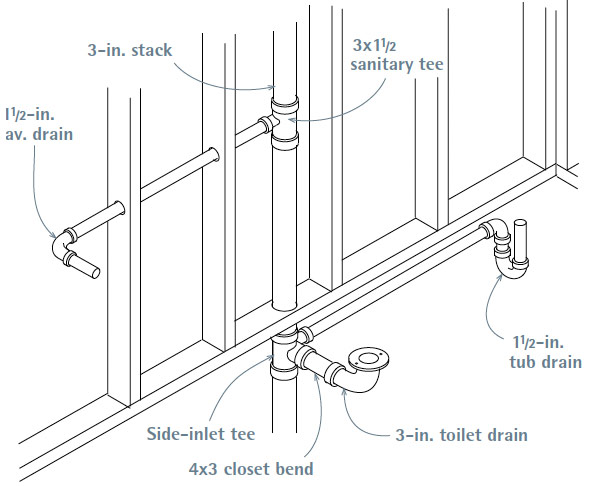The Function of Proper Ventilation in Ensuring Plumbing Systems
The Function of Proper Ventilation in Ensuring Plumbing Systems
Blog Article
We have discovered this article on The Upsides of Proper Ventilation in Plumbing Design down the page on the web and reckoned it made perfect sense to share it with you on this site.

Proper air flow in pipes systems is frequently overlooked, yet it is critical for maintaining the capability and safety and security of your home's pipes. Air flow assists manage air pressure, stop the buildup of dangerous gases, and ensure the effective removal of waste. In this guide, we will check out the importance of appropriate plumbing air flow, just how it works, and the benefits it brings to your pipes system.
Comprehending Air Flow in Pipes
Air flow in pipes refers to the network of pipelines that allow air to flow with the drain system. These vents offer multiple objectives, including managing atmospheric pressure within the pipelines, stopping sewage system gases from entering the home, and aiding in the smooth circulation of wastewater.
How Air Flow Functions in Pipes Solutions
Air Pressure Guideline
Appropriate ventilation preserves balanced atmospheric pressure within the pipes system. When water flows via pipes, it displaces air. Without ample ventilation, this variation can create unfavorable stress, causing reduce drains or siphoning of water from catches, which can create unpleasant smells to permeate into the home.
Preventing Drain Gas Build-up
Among one of the most vital features of plumbing vents is to avoid sewage system gases, such as methane and hydrogen sulfide, from gathering within the home. These gases can pose serious health dangers and are extremely combustible. Vent pipes allow these gases to leave safely outdoors.
Helping in Waste Elimination
Ventilation aids in the effective elimination of wastewater by stopping airlocks in the water drainage system. When air can flow easily through the vents, it permits water and waste to flow smoothly via the pipelines, lowering the threat of blockages and backups.
Types of Plumbing Vents
Key Stack Vent
The main pile air vent, additionally called the air vent pile, is the key vent in a pipes system. It expands from the primary drain line up through the roof, enabling gases to leave and fresh air to enter the system.
Branch Vent
Branch vents link to the main pile vent and serve private fixtures, such as sinks, commodes, and showers. These vents guarantee that each fixture has ample air flow to function effectively.
Air Admittance Valve (AAV).
An Air Admission Shutoff (AAV) is a one-way shutoff that permits air to get in the plumbing system without the need for a conventional vent pipe extending with the roof covering. AAVs are commonly utilized in improvements or areas where installing a conventional vent is impractical.
Signs of Poor Ventilation in Plumbing.
Slow Draining Fixtures.
If your sinks, tubs, or toilets are draining pipes gradually, maybe an indicator of inadequate air flow. Poor air flow can develop a vacuum cleaner effect, making it difficult for water to drain effectively.
Gurgling Sounds.
Gurgling sounds coming from drains pipes are usually an outcome of air being sucked via water catches due to adverse pressure in the pipelines. This is a clear sign of insufficient air flow.
Unpleasant Smells.
Sewer smells inside your home are a warning that your plumbing system is not effectively ventilated. This might mean that drain gases are not being appropriately aired vent outside, resulting in potentially harmful problems.
Typical Ventilation Errors.
Insufficient Vent Sizing.
Utilizing undersized vent pipes can result in bad air circulation and stress imbalances in the system. It's necessary to utilize vents that meet the certain demands of your plumbing system.
Improper Vent Placement.
Putting vents also far from the components they offer can reduce their effectiveness. Appropriate placement ensures that air can move easily and efficiently via the system.
Ignoring Code Requirements.
Building ordinance offer details guidelines for pipes ventilation. Overlooking these codes can result in a system that stops working to function appropriately and might result in pricey repairs or health hazards.
Advantages of Proper Air Flow.
Enhanced System Effectiveness.
Properly aerated pipes systems operate a lot more successfully, with less obstructions, faster draining pipes, and less pressure on the pipes. This efficiency extends the life expectancy of the plumbing system.
Improved Air High Quality.
By stopping drain gases from entering your home, appropriate air flow contributes to better interior air high quality, making your living atmosphere healthier and more comfy.
Avoiding Water Damages.
Sufficient ventilation assists avoid water from being siphoned out of catches, which can result in sewage system gases entering the home and creating water damage with time.
Steps to Make Certain Correct Air Flow.
Consulting Plumbing Codes.
Constantly consult neighborhood plumbing codes when making or customizing your plumbing system. These codes supply the required standards for appropriate airing vent and ensure your system meets safety standards.
Routine Assessment and Upkeep.
Routine inspections can help determine potential air flow issues before they become significant issues. Upkeep jobs, such as cleansing air vent pipelines and checking for blockages, are vital for keeping the system in good working order.
Professional Installment.
For brand-new installations or major alterations, it's smart to employ a professional plumber. They have the proficiency to make certain the ventilation system is correctly created and installed according to code.
Final thought.
Proper ventilation is a crucial part of any plumbing system, making sure that it works effectively and safely. By understanding the significance of air flow, recognizing the signs of inadequate air flow, and taking steps to keep your system, you can protect against costly issues and safeguard your home's air quality.
4 Things You Should Know About Your Plumbing Vents
What Plumbing Vents Are
Also called a vent stack, a plumbing vent is a vertical pipe attached to your drain line that runs through your roof. The plumbing vent pipe, or plumbing air vent, removes gas and odors from your plumbing system and allows fresh air to enter the pipes, helping the water to flow out of the drain pipes.
What Plumbing Vents Do
Plumbing vents have two basic functions. One of which is to allow unpleasant smelling wastewater and sewer gasses to escape your plumbing system instead of entering your home. Plumbing vent pipes are typically located on roofs, away from windows, to ensure the fumes exit the home completely.
The other function of the plumbing vent is to move fresh air into your plumbing system. This helps move water through every plumbing fixture in your house, like toilets and sink drains. Think of the way in which you need to let a little air into the bottle as you pour soda in order to make the drink flow smoothly.
Different Types of Plumbing Vents
True vent: This is the most common vent option. In simplest terms, a true vent is a vertical pipe attached to your drain line that exits through the roof. They often function as the main vent that other fixtures can connect to. Re-vent pipe or auxiliary vent: Attached to the drain line near specific plumbing fixtures, re-vent pipes run up and over to connect to the main vent. Common vent: Two plumbing fixtures installed on opposite sides of a wall are typically tied into the vent stack using something known as a sanitary cross. Wet vent: This venting option operates as a drain pipe and a vent at the same time. Wet vent drainage systems drain water from one fixture while venting the air from another. Although they’ve been used for over 100 years, wet vent systems have only recently been added to the plumbing code in many areas. If you’re planning on installing one in a bathroom remodel, make sure you check your local code prior to construction. Loop vent: For free-standing fixtures like kitchen island sinks, loop vents are ideal. These vent pipes run under the floor, rise from the P-trap, and create a loop inside the cabinet sink. Air admittance valve: An AAV is a one-way mechanical valve typically installed at the site of the plumbing fixture. AAVs allow venting to occur without having to tie into a larger venting system. They’re ideal for venting fixtures where you aren’t able to easily connect to an existing vent system. Common Plumbing Vent Issues
Although vent pipes typically don’t have water flowing through them, they’re still subject to many typical plumbing issues. For example, clogs are one of the most common problems associated with sewer vent pipes. If your vent pipe gets clogged, all of your plumbing fixtures tied into the vent stack will be affected.
A sink with a slow drain that bubbles and gurgles or a strong sewage smell around your toilet are both indicators that your toilet vent pipe is clogged. Because most vent pipes exit through the roof, old leaves, twigs or even a bird’s nest could be clogging the pipe.
Clogs in your vent pipe system cause a buildup of negative pressure, meaning that water won’t be able to flow out of your home very well. It’s similar to putting your finger over the opening of a straw to trap water inside. When you remove your finger, the water is able to flow out of the straw.
If you suspect you have any blockage in your vent, make sure you have a professional come examine the situation. Left unchecked, a blocked air vent can lead to other costly repairs, like leaks and sediment buildup.
Under Pressure
Pipe vents are essential aspects of a home’s plumbing system. Owning a home means learning about all sorts of things you never put much thought into before. But by understanding as much as you can about the important systems of your home, you can keep those budgets intact and those anxiety levels low.
https://www.homeserve.com/en-us/blog/home-improvement/plumbing-vents/

I have been very intrigued by The Upsides of Proper Ventilation in Plumbing Design and I am praying you enjoyed reading our post. Enjoyed reading our article? Please quickly share it. Help other people find it. We cherish reading our article about Why Plumbing Air Vents Are Important.
Request Free Estimate Report this page